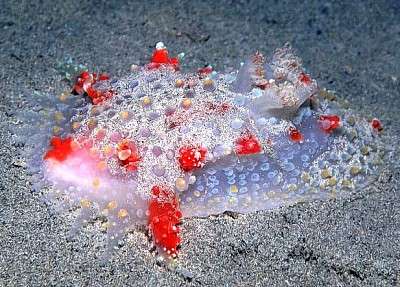
Kalinga ornata
Alder & Hancock, 1864
Order: NUDIBRANCHIA
Suborder: DORIDINA
Superfamily: ANADORIDOIDEA
Family: Polyceridae
Subfamily: Kalinginae
DISTRIBUTION
Indo-West Pacific.
PHOTO
Milne Bay, Papua New Guinea, March 1998, approx 65mm long. PHOTO: Mary Jane Adams. See message below.
This very large nudibranch apparently lives somewhere off shore as most records of it are from animals washed up like this on beaches. It grows to at least 130mm in length. It is related to animals like Plocamopherus imperialis but we know little about its biology.
It has been found throughout the Indo-West Pacific from South Africa to China and Japan. We know nothing about its natural history.
Reference:
• Alder, J. & Hancock, A. (1864). Notice of a collection of nudibranchiate mollusca made in India by Walter Elliot Esq. with descriptions of several new genera and species. Trans. Zool. Soc. London, 5: 113-147
Rudman, W.B., 1999 (November 17) Kalinga ornata Alder & Hancock, 1864. [In] Sea Slug Forum. Australian Museum, Sydney. Available from http://www.seaslugforum.net/find/kaliorna
Related messages
Kalinga ornata from NSW, Australia
November 17, 2009
From: Kristy Nash
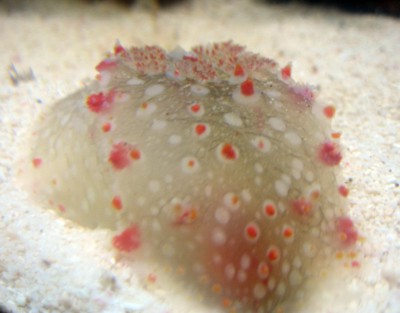
Hi
I found this sea slug washed up on a local beach on the mid north coast of NSW. I have tried to ID it but cannot find an exact match anywhere in my text books or on-line. The closest match I have found is a dendrodorid. Can anybody help ID this guy?
Locality: Port Macquarie, on shore, NSW, Pacific, 14 Nov 2009, floating in the shallows on shore. Length: approx 8-19 cm. Photographer: Kristy Nash.
Thanks
Kristy Nash
kristy_nash@hotmail.com
Nash, K., 2009 (Nov 17) Kalinga ornata from NSW, Australia. [Message in] Sea Slug Forum. Australian Museum, Sydney. Available from http://www.seaslugforum.net/find/22795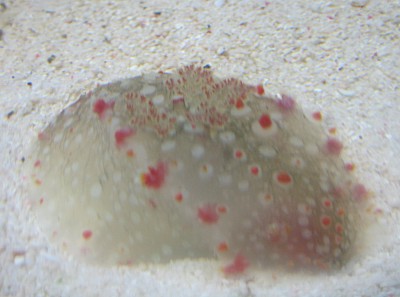
Dear Kristy,
This strange-looking dorid nudibranch is Kalinga ornata. It has been found in various places throughout the warm water regions of the Indian and West Pacific oceans. Have a look at the attached messages for other photos of this species. I suspect it is rarely seen because it lives in off-shore soft sediments [sand, sandy mud] and is only seen when storms wash it ashore.
We know nothing about its biology or natural history.
Best wishes,
Bill Rudman
Kalinga ornata from Singapore
November 14, 2007
From: Samson Tan
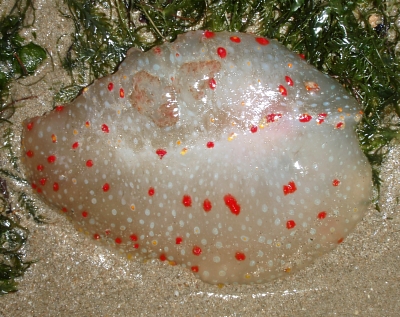

I found this large specimen of Kalinga ornata during my inter-tidal walk on 11th November 2007. This specimen seems to be the biggest as compared to all the previous signting. Hope this info is helpful in knowing a little bit more about this species.
Locality: Changi Beach, Singapore, NA. at the inter-tidal area, Singapore, Singapore Strait, 11 November 2007, Intertidal area, sea grass lagoon. Length: 170 mm. Photographer: Samson Tan.
Samson Tan
sos001y@yahoo.com
Tan, S., 2007 (Nov 14) Kalinga ornata from Singapore. [Message in] Sea Slug Forum. Australian Museum, Sydney. Available from http://www.seaslugforum.net/find/21116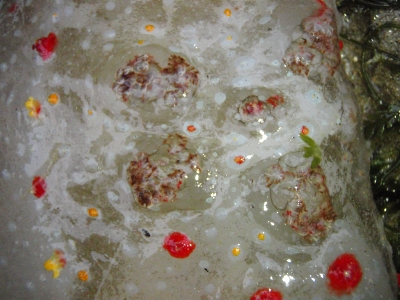
Dear Samson,
Thanks for this record. This is certainly a large specimen, and if it had been in water so it could fully extend, it would be even longer. We don't have many records of this species, which I suspect is because of its preferred habitat on soft bottoms - not the most favourite place for divers, or others looking for an abundance of spectacular animals.
Best wishes,
Bill Rudman
Re: Kalinga ornata from New South Wales
December 5, 2003
From: Lyn Cleary
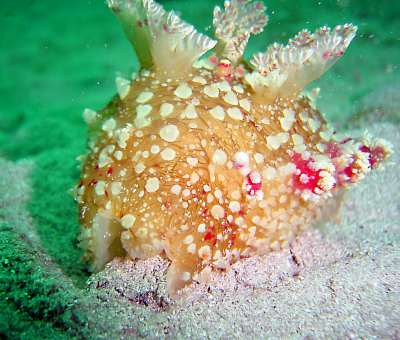
Dear Bill
I have a photo of Kalinga ornata, in fact several .I have observed it feeding. I found it on my favourite dive site, Murrays Sandline at Jervis Bay, New South Wales, [Australia]. Depth range 14-16mt. Its feeding was amazing, whilst ploughing through the sand it would stop and "shake'" for want of a more scientific word, my interpretation would be that it found some lovely morsel. It was alone as I did not see any other at that time or since. It is one of the most beautiful slugs I have seen.I have attached three photos and have more if you require
Lyn
dive@oceantrek.com.au
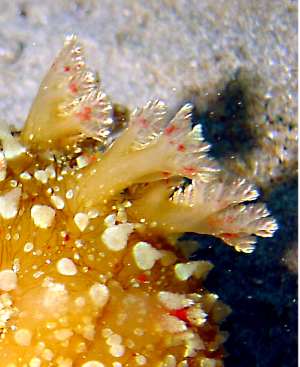
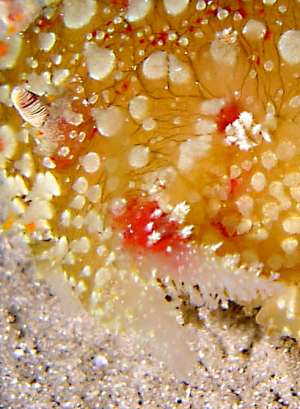
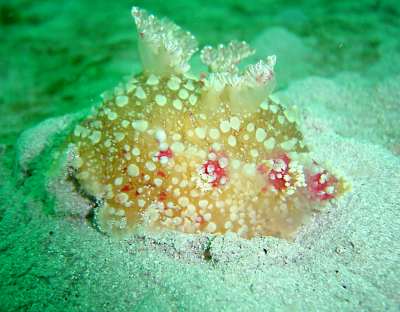
Thanks Lyn,
Your photos are a tantalising glimpse into the behaviour of this strange but beautiful looking animal. As I discuss in other messages, we know little of its behaviour and nothing about what it eats. I can't offer a prize but if you ever see one again we would really like to know what it was finding in the sand. I have included a close-up of the papillate tentacles it has along the edge of the oral veil which are almost certainly used to sense things in the sand as it is ploughing along. Can you give me a date when you took these photos please?
Best wishes
Bill Rudman
Kalinga ornata from deepwater off Hawaii
May 2, 2002
From: Dr. Christopher Kelley
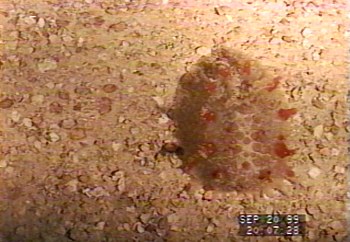
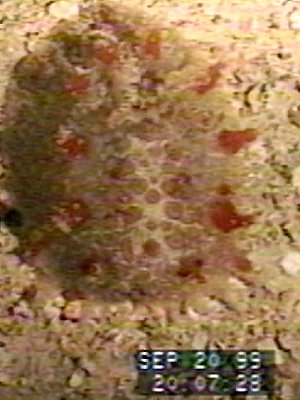
Hello everyone:
I am the program biologist for the Hawaii Undersea Research Laboratory. We conduct deepwater geological and biological research in Hawaii using submersibles and ROVs. During dives, researchers videodocument hundreds of different animals each year. I along with 2 part-timers, Dr. Deetsie Chave and Jane Culp are responsible for logging and identifying all of these animals which range from sponges to fishes. As you can imagine, we must often solicit help from real experts on the various phyla since, given the size of our group, it is impossible to thoroughly research each and every image. That's why I was very pleased when John Hoover told me about your Forum. I would be immensely grateful for any opinions regarding the ids of two photos. Cory Pittman has already suggested the first one could be Kalinga ornata and the second one Dendrodoris or Bathydoris sp. The K. ornata? (R-049-s1-06) was videotaped on a primarily sediment/pebble substrate at 182 meters in the main Hawaiian Islands. Thank you in advance for whatever help you can provide.
Dr. Christopher Kelley
ckelley@soest.hawaii.edu
Kelley, C., 2002 (May 2) Kalinga ornata from deepwater off Hawaii. [Message in] Sea Slug Forum. Australian Museum, Sydney. Available from http://www.seaslugforum.net/find/6768Dear Chris,
I agree with Cory that this is Kalinga ornata. Not much is known about this animal, and finding it at this depth is certainly a new bit of information. The only other opisthobranch I know with this depth range from shallow sunlittoral to 200m, is Umbraculum umbraculum, but more extensive sampling may prove its more common than we think. Any more photos of deepwater nudibranchs will always ne welcome.
Best wishes,
Bill Rudman
Spartacus - the Straddie blob
March 14, 2002
From: Lisa Miller
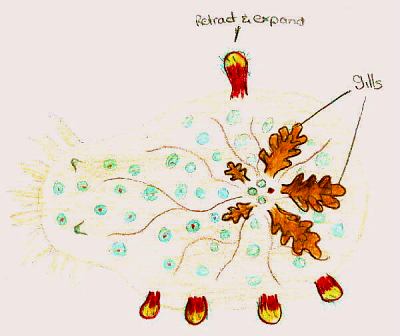
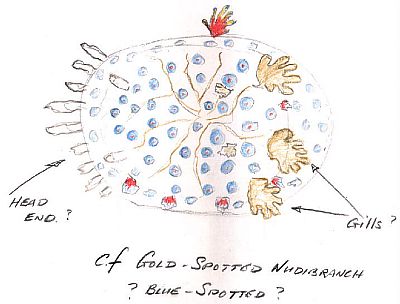
Hi! Just wondering if you could help me. I work at Kedron State High School in Brisbane [Queensland], and our Year 12 Biology students have just returned from a camp on Stradbroke Island [Moreton Bay, southern Queensland, Australia]. One of the girls found an interesting mollusc that we are having trouble identifying. (The kids have named it "Spartacus") It was on bare sand near Point Lookout, about 200m from a rocky outcrop that has heaps of rock pools. We are fairly certain it may have been washed up from these pools or maybe even from the mud flats and sea grass beds further down the island at Dunwich.
I have include pictures that were sketched of it, and if our photos turn out I may post them by the end of the week. Any help with this would be greatly appreciated, as our students this year are incredibly eager to learn.
Thanks,
Lisa Miller
Kedron State High School
Park Road, Wooloowin, 4030
limil9@kedronshs.qld.edu.au
Miller, L., 2002 (Mar 14) Spartacus - the Straddie blob. [Message in] Sea Slug Forum. Australian Museum, Sydney. Available from http://www.seaslugforum.net/find/6431Dear Lisa,
Your 'blob' is easily identifiable from the drawings. It is a nudibranch called Kalinga ornata which lives off-shore on sandy, or muddy-sand bottoms. Because of where it lives we don't know much about it, most animals that have been found, are like yours, washed ashore, probably after storms and feeling very sick and sorry. However Mary Jane Adams sent some wonderful photos to the Forum of Kalinga 'in the wild'. In its own environment it a much more beautiful and graceful animal - if rather peculiarly shaped - than the blob it looks like when washed ashore.
If you look at the other messages and photos of it on the Forum, you will see we have a number of records of it washing ashore in northern New South Wales and southern Queensland. We know very little about its biology and natural history - we don't even know what it feeds on, but its very broad oral veil with sensory tentacles along the edge suggest it is searching for something in the sand. Kalinga is one of a group of unrelated sea slugs with special adaptations for living in 'soft bottom' muddy-sand environments. If you have a look at the page for Euselenops luniseps you will see a link to a page where I discuss some of the adaotations they have evolved for this special environment.
Best wishes,
Bill Rudman
Kalinga ornata from Hong Kong
February 2, 2002
From: W.B. Rudman & B. W. Darvell
To help improve the known distribution of Kalinga ornata, here is some information on the one record of this species in Brian Darvell's Hong Kong collections.
Hong Kong Collection Records:
AM C140175, 2 specimens, 8 June 1983, Site -.88, 22°07.5' N, 116°59.9' E, 76 m (from trawl).
Reference:
• Rudman, W.B. & Darvell, B.W. (1990) Opisthobranch molluscs of Hong Kong. Part 1. Goniodorididae, Onchidorididae, Triophidae, Gymnodorididae, Chromodorididae, (Nudibranchia). Asian Marine Biology, 7: 31-79
Best wishes,
Bill Rudman & Brian Darvell
Re: Living Kalinga ornata
May 26, 2001
From: Andy Woerner
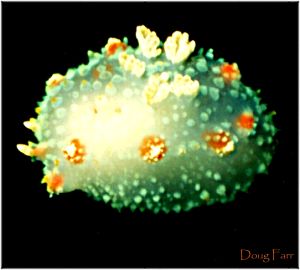
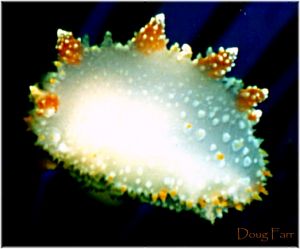
Dear Bill
I found this extremely interesting Nudi on a night dive last night [5 may 2001]in Kailua-Kona, Hawaii (The Big Island). We were doing our safety stop in about 110' of water with a sandy bottom. This little fellow drifted by and was just a few inches below the surfaces.
It appears to be very similar to the Kalinga ornata. Its interesting to note that I allowed it to rest on my hand (it did not try to grab on). Once it touched my skin, it erected the 4 red nodules that run down each side... but not to the extreme that Mary Jane Adam's photos show.
Sorry the pictures are so poor. They were captured by Doug Farr from my video and the lights were getting dim. It was around 11pm when we spotted it drifting a few inches below the surface. The terrain below us was a large expanse of sand and rubble for about at least a mile up and down the coast in either direction. There was a mild current running from south to north. The dive site was the wreck of "The Naked Lady" in Kailua Bay on the Big Island of Hawaii.
Andy Woerner
andywoerner@hotmail.com
Woerner, A., 2001 (May 26) Re: Living Kalinga ornata. [Message in] Sea Slug Forum. Australian Museum, Sydney. Available from http://www.seaslugforum.net/find/4395Dear Andy,
Thanks for this interesting message. Your observation is almost identical to Tim Hochgrebe's earlier message so it looks like Kalinga ornata makes a habit of floating around like an ungainly balloon. In Mary Jane Adam's photos the anterior red lateral tubercles are very long and extended because they are apparently acting like a dog's whiskers, sensing potential food or danger as the animal crawls along. I suspect these tubercles are extended by a combination of muscles and body fluids being pumped into them. from the Tim and Doug Farr's photos, when Kalinga is floating it puffs its body up into an almost spherical shape and the body fluids are presumably withdrawn from the tubercles, foot and oral veil, which are not needed for floating, and so become very reduced in size.
Thanks for sending these photos to the Forum, and thanks to Doug Farr for allowing us to use his photos.
Best wishes,
Bill Rudman
Living Kalinga ornata
December 18, 2000
From: Tim Hochgrebe
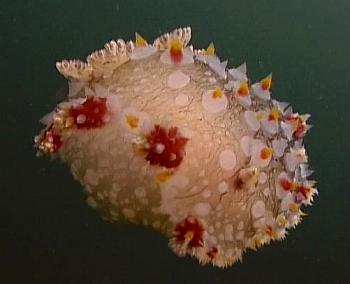
Dear Bill,
This is my first posting to the Seaslug Forum. We have established a new divers retreat in Byron Bay, New South Wales, called PLANULA (http://www.planula.com.au) and I am in the water with my videocamera most days of the week. The other day on a safety stop around Julian Rock this "thing" came floating past me and I got some nice video sequences of it. It turned out to be Kalinga ornata as found on Neville Coleman's old Nudibranch book title page. I just thought I share these images with you and I might start posting to this beautiful resource more regularly.
Tim Hochgrebe
tim@Planula.com.au
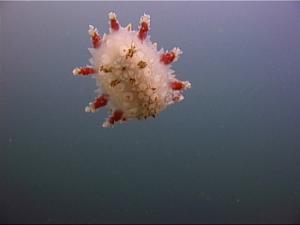
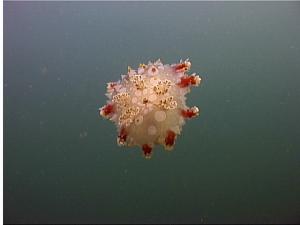
Dear Tim,
Thanks for the photos and the interesting observations. As you will have seen from Mary Jane Adam's earlier message, Kalinga is a bottom dweller, living in sandy mud habitats and has seldom been seen and photographed alive. I don't know if your observation of it floating past is a normal means of transportation, but I would suspect it may have got caught up in some current or tidal movement. It would be certainly interesting to hear of other similar observations.
I would welcome any other postings you would like to make to the Forum. It's a place where anyone interested in these animals can share their finds, their questions and their photos.
Best wishes,
Bill Rudman.
Kalinga ornata from Papua New Guinea
December 2, 1999
From: Mary Jane Adams

Dear Dr. Rudman,
I recently got an e-mail from Dave Behrens about the discussion of Kalinga ornata on your Forum website. It appears that I am one of the few people to have observed and photographed this nudibranch alive and feeding. Dave asked for my permission to send you one of my photographs from the slugsite where it was featured as "BOW" for week # 119. http://siolibrary.ucsd.edu/slugsite/nudwk119.htm
While I was waiting for Terry Goslinger to I.D. it for me, I just called it "The Alien." Here is the complete story that I wrote up for Dave and Terry last year:
I found The Alien on my thirteenth dive trip to Milne Bay. I am tempted to cheat a little and say he appeared on Friday the thirteenth on the night of the full moon, but actually it was one night earlier, March 12, 1998. The location is a shallow bay near the southern end of Normanby Island at Bunama Mission. This has been used as a night anchorage by dive boats for many years. However, being a remote area of PNG, only a very few divers visit here once a month or so. As a dive site it is some times referred to as Valerie's Beach. We generally explore a stretch of about three hundred yards from the anchorage. This part of the island is typical dense hardwood rainforest. A sand beach extends about twenty feet from the waterline. Below the waterline the sand slopes gradually to about 22 feet and then falls off at a steeper angle. The upper shelf is fairly clean sand has some sparse sea grass. The deeper slope is silty and has rotting leaves and tree trunks along with some trash. It is one of the fabulous New Guinea "muck dives" where you never know what will show up. The permanent residents include amemones with A. polymnus, branching amenones, sea cucumbers, sea pens, several species of starfish, cuttlefish, octopus, bobtail squid, several species of lionfish and rare scorpionfish , filefish, juvenile boxfish, numerous blue spot sting rays and many species of molluscs, shrimps and crabs. The sand is peppered with burrows of tiny mantis shrimp and garden eels starting only ten feet deep. I photographed the Armina sp. here that Debelius (p.291) says is only known from Bali and Flores and also Euselenops luniceps.
My highlight of the day had been photographing a flamboyant cuttlefish feeding at twelve feet. This was really a hot dive spot! I found The Alien about 9 pm. It was gliding over the sand on the verge of the drop off at about 20 feet. I knew immediately that it was not like anything I have ever seen before. The overall shape was especially striking with the two big red outriggers and twelve white projections in front. The gills looked like a typical nudibranch and were the only part of it that looked at all familiar. The body is translucent white with a slightly bluish cast. Some of the pustules scattered over it are yellow capped. The row of red crab-claw like projections along each side is especially startling. When viewed from the front it really does look like a creature from outer space with the short rhinophores for eyes and the big red spot in the middle of its "face." I tried to fan the sand off of it to get better photos, but it seemed to be adherent and I was afraid it would bury itself if I touched it. I laid my hand down next to it for size comparison and estimate it was about 65 mm long. It was moving fairly rapidly and the front fringes were held just about the sand, apparently searching out food. The feeding mechanism was fascinating. It would stop and the red mouth would slowly extend beyond the fringe and then a white inner tube came out through it and retrieved tiny bits from on top of the sand.
I finished off my roll of film and left two other divers to watch him while I went back to reload and get the skipper, Dave Miller. He got some great video of The Alien feeding. He has an excellent underwater rig and uses digital videotape. He has footage of The Alien hunting and close up views of it feeding. Dave reported that The Alien eventually burrowed into the sand and disappeared. The next night I was sick and didn't dive, but Dave found it again in the same place. We came back to Valerie's Beach on March 18, but The Alien didn't make an appearance.
This is one of the most beautiful and graceful nudibranchs I have ever seen. Pictures of dead ones don't do it justice. I hope you enjoy my photo.
Mary Jane Adams
Arcadia, California
mjadams@earthlink.net
Adams, M.J., 1999 (Dec 2) Kalinga ornata from Papua New Guinea. [Message in] Sea Slug Forum. Australian Museum, Sydney. Available from http://www.seaslugforum.net/find/1624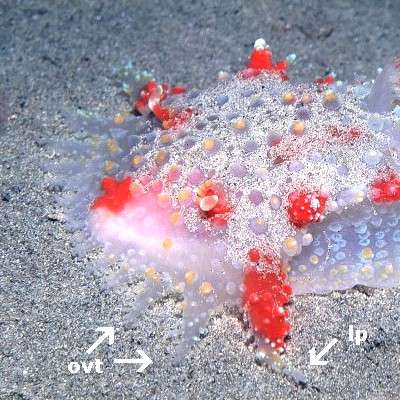
Dear Mary Jane,
Your email was a wonderful surprise. I don't know how I missed it on Mike Miller's site - too busy looking at my own I suppose.
Your photo certainly makes sense of Kalinga's strange shape. We guessed it was a sand dweller, because it has usually been found washed up on sandy beaches or in dredge or trawl samples. Your photo shows just how well adapted it is for a sandy life. I suspect the 'sand' on its back which you tried to wash off is its own colour pattern. As with related nudibranchs, such as Plocamopherus imperialis, the row of oral veil tentacles (OVT) around the anterior end of the head are sensory as you well describe, but it is great to read your observations and see the photo of how the large anterior lateral papillae (LP)- which you call the outriggers - are used. Clearly they are also sensory and instead of standing vertically as occurs in related species, they extend down to touch the substrate and so greatly increase the span of the sensory shield which is exploring the sand as the animal crawls along.
Your description of it stopping every now and then to ingest something is very tantalising. Related nudibranchs are bryozoan feeders, but it looks as though Kalinga is feeding on something else.
The sand-dwelling fauna is a very interesting but nor well-studied area of opisthobranch biology. In the last two weeks we have had many species of Cerberilla and now Kalinga. Another quite unrelated sand-dweller, which you mention, is the pleurobranch Euselenops luniceps. I have added a couple of pages to the Forum on this fascinating animal.
Thanks Mary Jane for the wonderful photo, and thanks Dave for tracking it down.
Best wishes,
Bill Rudman.
Kalinga ornata from New South Wales
November 18, 1999
From: Ann Lawson
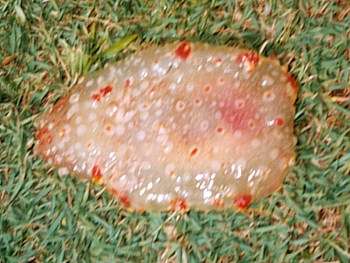
Dear Bill,
My grandson found this slug washed up on a sandy beach north of Sydney. Can you help us identify it please?
Ann Lawson
Cromer,
New South Wales.
Dear Ann,
It is Kalinga ornata. This very large nudibranch apparently lives somewhere off shore as most records of it are from animals washed up like this on beaches. It grows to at least 130mm in length. It is related to animals like Plocamopherus imperialis but we know little about its biology. When it is alive the gills are very large, and the red bits down each side are quite long branched papillae.
It has been found throughout the Indo-West Pacific from South Africa to China and Japan. We know nothing about its natural history.
Unfortunately I don't have a good photo of a live animal. Hopefully someone will help us to get one for the Forum.
Bill Rudman.
Rudman, W.B., 1999 (Nov 18). Comment on Kalinga ornata from New South Wales by Ann Lawson. [Message in] Sea Slug Forum. Australian Museum, Sydney. Available from http://www.seaslugforum.net/find/1546Re: Kalinga ornata
November 18, 1999
From: Richard Willan
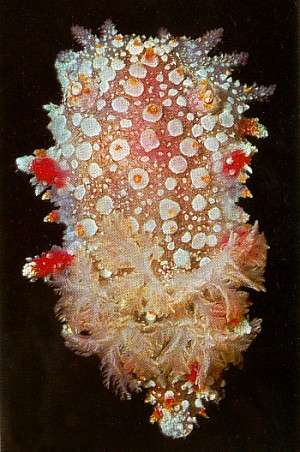
Dear Bill,
Concerning Ann's Kalinga message. You are welcome to use my picture of Kalinga on the Sea Slug Forum.
It was only just alive when photographed. I was lucky to discover 18 moribund animals washing around in the surf on Currumbin Beach [southern Queensland]during a storm in January 1982. Just this one was sufficiently "lively" to be taken back to Brisbane and photographed that night, but it was dead by the next morning. It measured 95 mm extended crawling length. I often wonder what Kalinga feeds on, and how it gets its food.
Cheers,
Richard
Richard.Willan@nt.gov.au
Willan, R., 1999 (Nov 18) Re: Kalinga ornata. [Message in] Sea Slug Forum. Australian Museum, Sydney. Available from http://www.seaslugforum.net/find/1549Thanks Richard,
It's the most 'alive' looking photo I have seen. Usually I am given a photo like Ann's of a washed up animal, which clearly doesn't do these animals justice.
Best wishes,
Bill Rudman.
